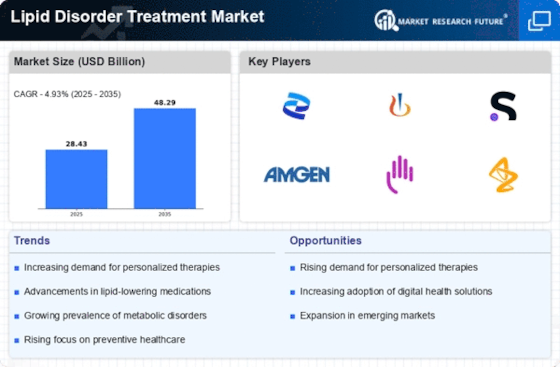Regulatory Support for New Treatments
Regulatory bodies are playing a pivotal role in shaping the Lipid Disorder Treatment Market by facilitating the approval of new therapies. Streamlined approval processes and incentives for the development of innovative lipid-lowering agents are encouraging pharmaceutical companies to invest in research and development. For instance, the expedited review pathways for breakthrough therapies have led to the rapid introduction of effective treatments into the market. This regulatory support not only accelerates patient access to novel therapies but also fosters competition among manufacturers, which may lead to more affordable treatment options. As regulatory frameworks continue to evolve, the Lipid Disorder Treatment Market is likely to experience significant growth, driven by the introduction of new and effective treatment modalities.
Advancements in Pharmaceutical Research
Innovations in pharmaceutical research are transforming the Lipid Disorder Treatment Market. The development of novel lipid-lowering agents, such as PCSK9 inhibitors and novel formulations of statins, has expanded treatment options for patients. These advancements not only enhance efficacy but also improve patient adherence to treatment regimens. For instance, recent studies indicate that PCSK9 inhibitors can reduce LDL cholesterol levels by up to 60 percent, showcasing their potential in managing lipid disorders. Additionally, the introduction of combination therapies is likely to provide more comprehensive treatment solutions, addressing multiple lipid abnormalities simultaneously. As a result, the market is witnessing a shift towards more effective and personalized treatment approaches, which could significantly impact the Lipid Disorder Treatment Market in the coming years.
Increasing Prevalence of Lipid Disorders
The rising incidence of lipid disorders, such as hyperlipidemia and dyslipidemia, is a primary driver of the Lipid Disorder Treatment Market. According to recent estimates, nearly 40 percent of adults are affected by elevated cholesterol levels, which significantly heightens the risk of cardiovascular diseases. This alarming trend necessitates effective treatment options, thereby propelling market growth. As healthcare providers increasingly recognize the importance of managing lipid levels, the demand for innovative therapies and medications is likely to surge. Furthermore, the aging population, which is more susceptible to lipid disorders, contributes to the expanding patient base. Consequently, pharmaceutical companies are investing in research and development to create advanced lipid-lowering agents, which may further stimulate the Lipid Disorder Treatment Market.
Growing Awareness of Cardiovascular Health
There is a notable increase in awareness regarding cardiovascular health, which is driving the Lipid Disorder Treatment Market. Public health campaigns and educational initiatives have highlighted the importance of maintaining healthy lipid levels to prevent heart disease. This heightened awareness is prompting individuals to seek medical advice and undergo lipid profiling, leading to early diagnosis and treatment of lipid disorders. Moreover, healthcare professionals are increasingly advocating for routine lipid screenings, particularly among high-risk populations. As a result, the demand for lipid-lowering therapies is expected to rise, as more patients are identified and treated for lipid abnormalities. This trend underscores the critical role of education and awareness in shaping the Lipid Disorder Treatment Market.
Integration of Lifestyle Modification Programs
The integration of lifestyle modification programs into lipid disorder management is emerging as a crucial driver of the Lipid Disorder Treatment Market. Healthcare providers are increasingly recognizing that pharmacological interventions alone may not suffice in managing lipid levels effectively. Consequently, comprehensive treatment plans that include dietary changes, physical activity, and behavioral modifications are being emphasized. Studies suggest that lifestyle interventions can lead to a 10-20 percent reduction in LDL cholesterol levels, complementing pharmacotherapy. This holistic approach not only enhances treatment outcomes but also empowers patients to take charge of their health. As more healthcare systems adopt this integrated model, the Lipid Disorder Treatment Market is likely to benefit from a growing emphasis on preventive care and long-term management strategies.

















Leave a Comment